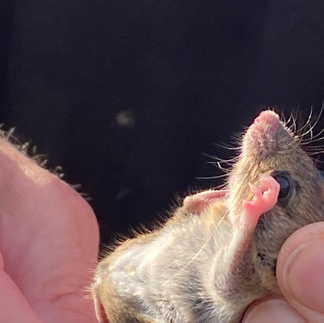On the hunt for small mammals
- Crone

- Oct 2, 2022
- 4 min read
Now, here’s a thing: in the dormouse course, Henry Stanier said that the dormouse was the only small mammal with a furry tail. At the time, I thought, squirrel? Weasel? Stoat? But it turns out that small mammal is a specific term – it is a subdivision determined by size (very small) that includes mice, shrews and voles – except water voles which are too big to be small mammals.
This course, then, was concerned with a particular group of little critters and was led by Peter Pilbeam. I was tasked with taking the refreshments and some other bits and bobs from the Wildlife Trust office to the site and so ended up spending a fair bit of time with Peter, which I enjoyed. It turns out that he has monitored snow leopards in the Himalayas and has seen 19 separate individual of this stunning and rare species.
Happily, he was just as keen to talk to us about mice.
The course is designed to introduce you to trapping and recording. So we learnt how to bait traps and where to put them and the protocols involved in surveying.
On the first evening of the course, we set up twenty traps around the reserve and the following morning checked them all.
You have to be careful when extricating the small animal from the trap. It is then sexed, weighed and released where it was found.
Here’s Peter getting a bank vole out of the trap.

She was a female and rather sweet.
This is a wood mouse – one of the five female wood mice we trapped.
And this is the release of a wood mouse – another female.
We recorded the data – one female bank vole, five female wood mice (two of which were lactating) and four male wood mice.
Later we dissected owl pellets. Many field vole bones, a few shrews (so tiny!) and a mouse. I should have taken pictures – two sisters did such a great job of the dissection that their collections of bones, organised by size, looked like museum exhibits.
Peter told us that shrews need to eat and rehydrate almost constantly, or else they die. Hence, you must always put some bait in the box that will keep shrews alive. If you are deliberately trapping shrews, you need a license (not hard to get) and if one dies, you have to report it.
This is all very noble… but I can’t help wondering what that data is for? I mean, even if the numbers were declining it’s not like anyone (politicians or developers) would care. Only the owls and foxes and stoats and weasels. Again, I have this sense that we humans always want more data, more facts to grasp hold of (and more small bodies to grasp hold of) and more photos and more knowledge… when, actually, what we need to do is stop polluting, stop destroying habitats, stop increasing our numbers.
Here’s a crazy thing: if your cat brings in a mouse, great, you can record it as a dead mouse. You have earned a data point which you would not have had had your cat not (needlessly) killed the mouse. That’s like saying, if you leave a landmine in Amboseli and an elephant blows itself up, yippee, you know you have one more elephant to add to the data sheet. Shame it’s dead. Cats, like landmines, will kill creatures, at some point.
The small mammals matter in their own right, as do elephants; and they matter to owls and other predators – just as elephants matter to the animals who relied on them to knock down trees and open up the forest. Cats and landmines don’t just impact mice and elephants, but everyone else too.
Apparently, decision-makers only act on data – but they can always ask for more data, and they do. Which means that data becomes what matters rather than animals and networks. What comes to matter is the graphs we can draw not the lives being lived.
In the course, we did not learn what mice do with their lives – how they organise, communicate, mate… we didn’t learn what life might be like for mice.
My sister-in-law did tell me something though. One of her cats caught a shrew – they usually don’t eat shrews because shrews are not that tasty to cats. This shrew was in the house and Elise said it was behaving strangely, like it was mad or drunk. She said, after what I told her about the food and dehydration, that maybe it was desperate for sustenance. She picked it up and took it outside. When she put the shrew down, it turned out there was a slug there and the shrew immediately leapt on it and started to eat. Elise thought it was vicious! My brother said that pound for pound, shrews are the most vicious hunters – and we all said, well of course they are if they have to eat every thirty minutes or so. Just think how stressful it must be to be a shrew!
I did very much like Peter though and as a result, I signed up to be a member of the Mammal Society. Sadly, there is now county group of the society. If I want to do anything with mammals, I have to go to Cambridgeshire. And Peter is the chair of that branch.





















Very interesting! Especially the info and story about shrew!! p.s. (But no photo of the dormouse's furry tail !?) 😁